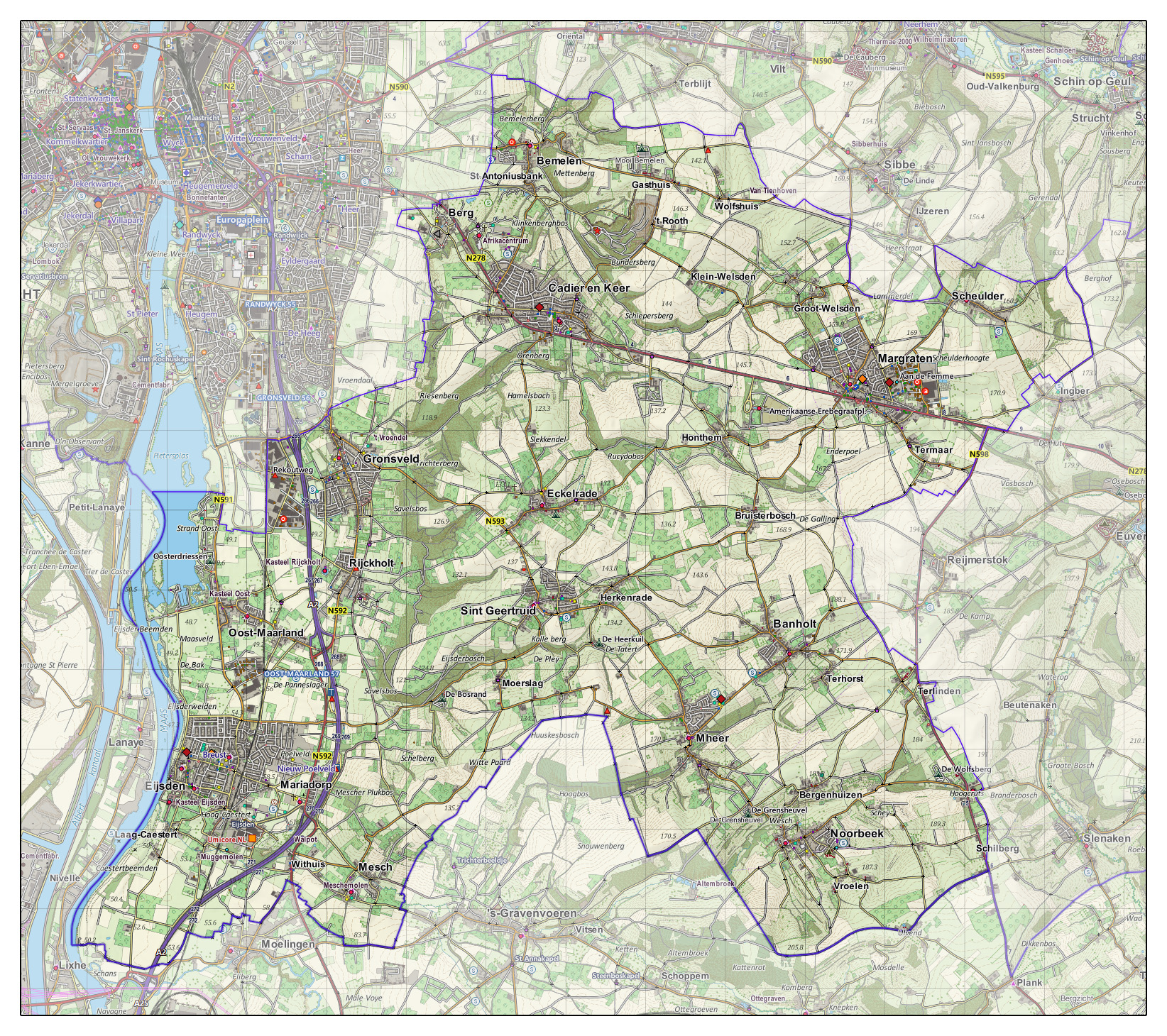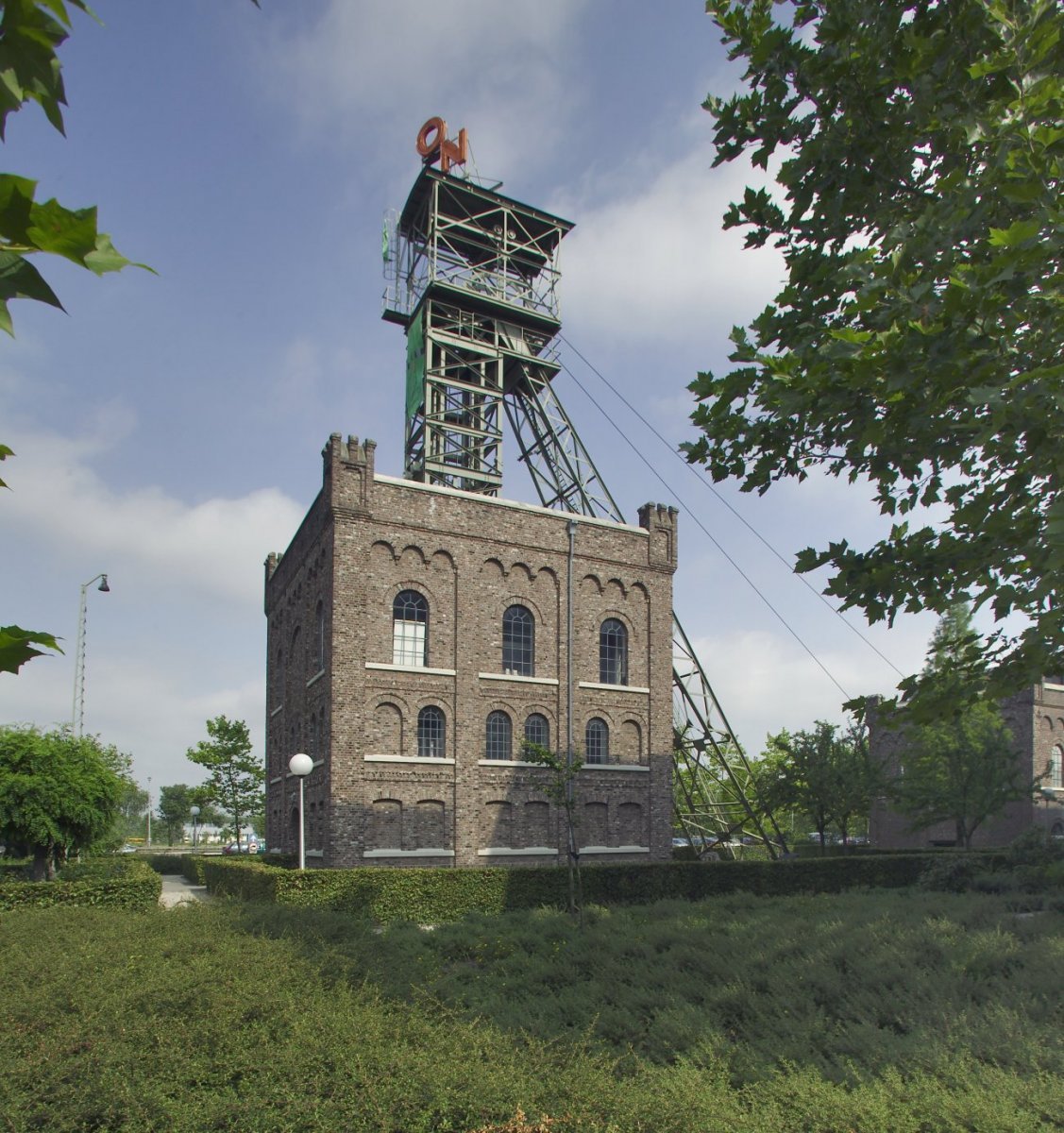|
Oost-Maarland
Oost-Maarland is a village in the south east of the European country Netherlands. There it is an administrative population centre in the Eijsden-Margraten municipality, which forms part of the Province of Limburg. In fact Oost-Maarland consists of two separate places with a different history. One is the village and former municipality of Oost, whereas the other is an in a distance of a few hundred metres separately to the southeast situated township called Maarland. Oost-Maarland is located some 3 km north of Eijsden, the biggest place in the municipality and south of Maastricht, the provincial capital. In its northeast it borders Rijckholt and in its east and southeast the Sint Geertruid part of the Savelsbos hillside forest, which is part of the "Margraten plateau". In the west it borders the Meuse river, across which marks the border with Belgium, specifically the Liège province of Wallonia. Inbetween Maarland and this forest since a few decennia passes the E25 high ... [...More Info...] [...Related Items...] OR: [Wikipedia] [Google] [Baidu] |
Oost, Limburg
Oost is a village (and a former municipality) in the south of the Netherlands. There it is situated near the "Maas" ("Meuse") river in the southwestern part of the province of Limburg. Oost is the larger part of the merged administrative population centre of Oost-Maarland, which is part of the municipality of Eijsden-Margraten. This municipality borders with Belgium to the south and to the west. To the west that border mostly corresponds with the Meuse river. As Oost is situated in the westernmost part of this municipality, to the west its outlying area borders the Meuse river and Belgium. Oost has more than 600 inhabitants and is situated south of the city of Maastricht and 3 kilometers north of Eijsden, which is the largest place in the municipality. History The region around Oost has a complex history, but significantly, many centuries ago, Oost was a seignory and its own municipality and a "ban" (judicial district) of the Dalhem county. Since the Peace of Münster in 16 ... [...More Info...] [...Related Items...] OR: [Wikipedia] [Google] [Baidu] |
Eijsden-Margraten
Eijsden-Margraten (; ( li, Èèsjde-Mergraote) is a municipality situated in the very south of the Netherlands. There it is located in the southeastern part of the province of Limburg. This municipality was formed in 2011 from the former municipalities of Eijsden and Margraten, that both consisted of a number of separately situated villages. As a result, the nowadays Eijsden-Margraten municipality consists of 28 villages and townships, spread out over 15 administrative centres. As of 2011, it has a population of about 25,000. Eijsden-Margraten is one of the most southerly municipalities in the Netherlands, for in its south it is extending up to the most southerly part of the border between the Netherlands and Belgium. The Meuse river, coming from France and Belgium, at Eijsden enters its third and final flowing country, the Netherlands. From here on its name in Dutch is "Maas". Running northward to Eijsden-Margraten's west it locally forms the westerly frontier of the last mention ... [...More Info...] [...Related Items...] OR: [Wikipedia] [Google] [Baidu] |
Eijsden
Eijsden (; li, Èèsjde ) is a village situated in the very south of the European country the Netherlands. It is located in the southwestern part of the province of Limburg. Until 1 January 2011, Eijsden was the main village in a municipality with the same name. On that date this municipality merged with the neighbouring one of Margraten, resulting in nowadays Eijsden-Margraten municipality, in which Eijsden again is the biggest place. This village is one of the most southerly places in the Netherlands, for in its south it is extending up to the most southerly part of the border between the Netherlands and Belgium. The Meuse river, coming from France and Belgium, here enters its third and final flowing country, the Netherlands. From here on its name in Dutch is ''Maas''. Running northward to Eijsden's west it locally forms the westerly frontier of the last mentioned country with Belgium. Its Belgian border across the Meuse is Lanaye, a village of Liège Province in Wallonia, ... [...More Info...] [...Related Items...] OR: [Wikipedia] [Google] [Baidu] |
List Of Sovereign States
The following is a list providing an overview of sovereign states around the world with information on their status and recognition of their sovereignty. The 206 listed states can be divided into three categories based on membership within the United Nations System: 193 UN member states, 2 UN General Assembly non-member observer states, and 11 other states. The ''sovereignty dispute'' column indicates states having undisputed sovereignty (188 states, of which there are 187 UN member states and 1 UN General Assembly non-member observer state), states having disputed sovereignty (16 states, of which there are 6 UN member states, 1 UN General Assembly non-member observer state, and 9 de facto states), and states having a special political status (2 states, both in free association with New Zealand). Compiling a list such as this can be a complicated and controversial process, as there is no definition that is binding on all the members of the community of nations concerni ... [...More Info...] [...Related Items...] OR: [Wikipedia] [Google] [Baidu] |
Wallonia
Wallonia (; french: Wallonie ), or ; nl, Wallonië ; wa, Waloneye or officially the Walloon Region (french: link=no, Région wallonne),; nl, link=no, Waals gewest; wa, link=no, Redjon walone is one of the three regions of Belgium—along with Flanders and Brussels. Covering the southern portion of the country, Wallonia is primarily French-speaking. It accounts for 55% of Belgium's territory, but only a third of its population. The Walloon Region and the French Community of Belgium, which is the political entity responsible for matters related mainly to culture and education, are independent concepts, because the French Community of Belgium encompasses both Wallonia and the bilingual Brussels-Capital Region. There is a German-speaking minority in eastern Wallonia, resulting from the annexation of three cantons previously part of the German Empire at the conclusion of World War I. This community represents less than 1% of the Belgian population. It forms the German-speak ... [...More Info...] [...Related Items...] OR: [Wikipedia] [Google] [Baidu] |
Frank Wassenberg
Frank P. Wassenberg (born 2 May 1966) is a Dutch politician. He is a member of the House of Representatives for the Party for the Animals since 23 March 2017. He previously served in the House from 17 November 2015 to 18 October 2016 when he temporary replaced Esther Ouwehand. He serves in the States of Limburg since the 2015 elections, and previously served between 2007 and 2011. Career Wassenberg was born on 2 May 1966 in Heer, Maastricht. After completing his high school education in Maastricht in 1985 he went to study biology at Utrecht University and graduated in 1992. Since 1993 he has worked as a policy officer for various foundations for animal rights, since 2006 for the . Wassenberg was elected to the States of Limburg for the Party for the Animals in the 2007 elections. He served one four-year term. In the 2011 elections the party did not manage to obtain any seats. In the 2015 elections Wassenberg was once more elected to the States, as the sole representative of t ... [...More Info...] [...Related Items...] OR: [Wikipedia] [Google] [Baidu] |
Heerlen
Heerlen (; li, Heële ) is a city and a municipality in the southeast of the Netherlands. It is the third largest settlement proper in the province of Limburg. Measured as municipality, it is the fourth municipality in the province of Limburg. Heerlen forms part of the city-region of Parkstad Limburg, an agglomeration with about 250,000 inhabitants and encompassing 8 municipalities. It is to the east of Maastricht and north of the German city of Aachen. After its early Roman beginnings and a modest medieval period, Heerlen became a centre for the coal mining industry in the Netherlands in the late 19th century. In the 20th century, architect Frits Peutz played a major role in shaping the city as we know it today. His most famous design, and a distinctive building in the city centre, is the so-called Glaspaleis (''Glass Palace''), listed as one of the world's thousand most architecturally important buildings of the 20th century. History A habitation from the Michelsberg culture ... [...More Info...] [...Related Items...] OR: [Wikipedia] [Google] [Baidu] |
Augusta Of Treviso
Saint Augusta of Treviso, also known as ''Augusta of Ceneda'', ''Augusta of Tarvisium'', or ''Augusta of Serravalle'', is venerated as a virgin martyr. Background Her ''Acts'' were written in the 16th century by Minuccio Minucci di Serravalle, who was secretary to Pope Clement VIII and Protonotary apostolic. According to her legendary ''Acts'', Augusta was the daughter of Matrucus, pagan chief of the Alemanni. Matrucus had conquered the Friulians, who had been Christianized, and ruled over them. Augusta converted to Christianity secretly. Her father had sent spies to watch over her, and one day, when he discovered her praying, he imprisoned her, and then knocked out all of her teeth.Sabine Baring-Gould, ''The lives of the saints'', Volume 3 (J. Hodges, 1872), 483. Her enraged father then tortured and decapitated her with his sword at Serravalle, a district of the present-day Vittorio Veneto, around 100 AD. Some sources state that her death took place in the 5th century. V ... [...More Info...] [...Related Items...] OR: [Wikipedia] [Google] [Baidu] |
Margraten
Margraten (; li, Mergraote) is a village and a former municipality in the southeastern part of the Netherlands. On 1 January 2011 this former municipality merged with a neighbouring one, which resulted in the new Eijsden-Margraten municipality. Preceding developments Until 1982 the municipality with this name comprised, beside Margraten, the hamlets Groot Welsden, Klein Welsden, Termaar and 't Rooth. In 1982 this municipality was extended with a number of neighbouring municipalities: Cadier en Keer, Mheer, Noorbeek and Sint Geertruid. Also the village Scheulder, that until then was part of another municipality, was added. As a result, from 1982 until 2011 the municipality of Margraten comprised the following population centres, that from 2011 on are all part of nowadays municipality of Eijsden-Margraten. American Cemetery At Margraten the Netherlands American Cemetery and Memorial is situated. Established in 1960, it is Europe's third largest war cemetery for unidentifi ... [...More Info...] [...Related Items...] OR: [Wikipedia] [Google] [Baidu] |
Breust
Breust is a former village in the Dutch province of Limburg. It is located in the municipality of Eijsden-Margraten, and is now a neighbourhood of Eijsden. Breust was a separate municipality until 1828, when the area was divided between the municipalities of Eijsden and Sint Geertruid Sint Geertruid (Limburgish: ''Se-Gietere'') is a village in the Dutch province of Limburg. It is located the municipality of Eijsden-Margraten. History The village was first mentioned in 1178 as "in monte". The current name is reference to Gert ....Ad van der Meer and Onno Boonstra, "Repertorium van Nederlandse gemeenten", KNAW, 2006. References Former municipalities of Limburg (Netherlands) Eijsden-Margraten {{LimburgNL-geo-stub ... [...More Info...] [...Related Items...] OR: [Wikipedia] [Google] [Baidu] |
Peace Of Münster
The Peace of Münster was a treaty between the Lords States General of the Seven United Netherlands and the Spanish Crown, the terms of which were agreed on 30 January 1648. The treaty, parallelly negotiated to but not part of the Peace of Westphalia, is a key event in Dutch history, marking the formal recognition of the independent Dutch Republic and the end of the Thirty Years' War and the Eighty Years' War. Background Negotiations Negotiations between began in 1641 in the towns of Münster and Osnabrück, in present-day Germany. With the initiation of Spanish-Dutch peace talks, Dutch trade with the Levant and the Iberian Peninsula began to flourish. Dutch merchants, benefiting from both the availability of relatively cheap shipping and the cessation of hostilities, soon dominated the markets that had been previously dominated by English traders. Dutch merchants would also benefit from the foreign upheavals of the English Civil War and gain on English trade in their ... [...More Info...] [...Related Items...] OR: [Wikipedia] [Google] [Baidu] |




.jpg)